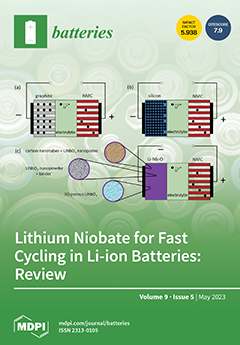Nickel phosphide (Ni
2P), as an anode material for both lithium- and sodium-ion batteries, offers high theoretical specific and volumetric capacities. However, considerable challenges include its limited rate capability and low cycle stability arising from its volume change and degradation during cycling.
[...] Read more.
Nickel phosphide (Ni
2P), as an anode material for both lithium- and sodium-ion batteries, offers high theoretical specific and volumetric capacities. However, considerable challenges include its limited rate capability and low cycle stability arising from its volume change and degradation during cycling. To solve these issues, appropriate composite micro/nanoparticle designs can improve conductivity and provide confinement. Herein, we report a simple pyrolysis method to synthesize nitrogen-doped carbon-coated Ni
2P nanorod arrays (Ni
2P@NC) from nickel foam and an ionic resin as a source of carbon, nitrogen and phosphorus. The N-doped open-ended carbon shells provide Ni
2P containment, good electrical conductivity, efficient electrolyte access and the buffering of bulk strain during cycling. Consequently, as a LIB anode material, Ni
2P@NC has impressive specific capacity in long-term cycling (630 mAh g
−1 for 150 cycles at 0.1 A g
−1) and a high rate capability of 170 mAh g
−1 for 6000 cycles at 5 A g
−1. Similarly, as a SIB anode, Ni
2P@NC retains a sizable 288 mAh g
−1 over 300 cycles at 0.1 A g
−1, and 150 mAh g
−1 over 2000 cycles at 2 A g
−1. Furthermore, due to a sizable portion of its capacity coinciding with adequately low voltage, the material shows promise for high volumetric energy storage in full-cell format. Lastly, the simple synthesis method has the potential to produce other carbon-coated metal phosphides for electrochemical applications.
Full article





